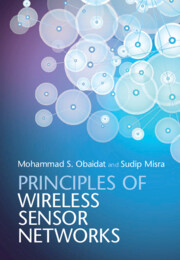Book contents
- Frontmatter
- Dedication
- Contents
- Preface
- 1 Introduction to wireless sensor networks
- 2 Inside a wireless sensor node: structure and operations
- 3 Wireless sensor network applications: overview and case studies
- 4 Medium access in wireless sensor networks
- 5 Routing in wireless sensor networks
- 6 Transport protocols for wireless sensor networks
- 7 Localization and tracking
- 8 Topology management and control
- 9 Performance evaluation of wireless sensor networks
- 10 Security issues in wireless sensor networks
- 11 Wireless mobile sensor networks
- 12 Wireless multimedia sensor networks
- 13 Underwater sensor networks
- 14 Wireless underground sensor networks
- References
- Subject index
- References
5 - Routing in wireless sensor networks
Published online by Cambridge University Press: 05 December 2014
- Frontmatter
- Dedication
- Contents
- Preface
- 1 Introduction to wireless sensor networks
- 2 Inside a wireless sensor node: structure and operations
- 3 Wireless sensor network applications: overview and case studies
- 4 Medium access in wireless sensor networks
- 5 Routing in wireless sensor networks
- 6 Transport protocols for wireless sensor networks
- 7 Localization and tracking
- 8 Topology management and control
- 9 Performance evaluation of wireless sensor networks
- 10 Security issues in wireless sensor networks
- 11 Wireless mobile sensor networks
- 12 Wireless multimedia sensor networks
- 13 Underwater sensor networks
- 14 Wireless underground sensor networks
- References
- Subject index
- References
Summary
A number of factors have to be considered carefully when implementing network protocols for wireless sensor networks (WSNs). Any routing protocol for WSNs should take into consideration the limited energy resources in the sensor nodes. Moreover, WSNs are distinctive from basic ad-hoc networks with respect to communication channels. Generally, the sink nodes are more concerned with an overall depiction of the environment than with precise readings from their own sensor devices. Hence, the communication in the WSN is known as data-centric rather than address-centric and the data may be collected locally rather than transmitted raw to the sink(s). All of these distinctive features of WSNs play a part in the network layer and thus data routing protocols need to be thought of carefully.
In order to access data, sensors rarely have knowledge of their own locations and these locations can be used for routing functions in the network layer. If a WSN is well connected, the services of the topology control have to be utilized in conjunction with the general routing protocols. To the end of dealing with specific network issues in the routing layer, we find ourselves dealing with a different routing layer from traditional networks.
In this chapter, we will review the major aspects of routing in WSNs, including various types of routing protocols and related advantages, and disadvantages, as well as challenges [1–58].
- Type
- Chapter
- Information
- Principles of Wireless Sensor Networks , pp. 76 - 104Publisher: Cambridge University PressPrint publication year: 2014

